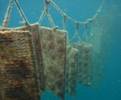Aquaculture Commodities Production Activities
The main goal for Aquaculture activities just to develop practical cost-effective aquaculture opportunities for endemic marine species or fisheries resources, which produce high commercial impacts directly to the local fishers or communities. The customary significance and improvement of livelihood are the main focal point throughout the working plan annually.




Wing Pearl Oyster – Pteria penguin
Spawning induction programme was conducted in late May as ongoing activities from previous year (2008) under ACIAR Project to the Pacific regions included Tonga. The result from 2008 spawning induction, 1,200 spats had been distributed among 4 active pearl oyster farmers down in Vava’u, which part of the proposal assistance and support from the Government to develop pearl oyster industry currently operated at Vava’u coastal waters. More farmers had been participated in a way to get spats from the Government under this project which one of the good sign for this project. In fact, support activities will be up to the final stage in term of establishing international market for their product (‘Mabe’) as part of the Project expected outcome.
Giant Clams – Tridacna spp
Three species were induced to spawn but only Tridacna derasa, known locally ‘Tokanoa’ managed to release eggs similar to year 2008. Other two species, T.squamosa and T.maximawere hardly to spawn and could be associated with their maturity stage (i.e. not yet reach to their maturity stage – spawning stage). These brooders were kept at ‘Atata clam circle (Community Special Management Areas) after spawning induction at the previous year (2008). There was a need to collect broodstock for this year spawning induction programme but could not able to do so due to a fact that not enough fund as allocated from the Budget for Fiscal Year 2009-10 under Aquaculture Section to cover this activity.
Live Corals and Rocks Cultured.
The launch of Live coral and rocks project was entitled to facilitate and compensate the wild harvest under allocation quotas issued by the Government to the Aquarium Operators. In fact, wild harvest of live rocks was banned in 2008 included reduction the numbers and species of live corals allow to ship in weekly basis for 4 exporters currently had license to harvest and export aquarium commodities (i.e. aquarium fishes, invertebrates, live corals and rocks) to the international markets. This project was one of the Mini Project funded by ACIAR through SPC technical assistance to the regions included Tonga.
Four sites were selected for the ocean cultured for artificial corals whereas only one site man made rocks. For the rocks, around one thousands rocks already transferred to the ocean site with monthly monitoring programme was also established. For the corals, more than 3 thousands were transferred to the selected sites but the growth rate varied between sites. As a result, site selection still on trail due to the fact that surrounding environment quite milky and not very suit the growth performance of some certain coral species. However, market trail for some artificial corals was also conducted by one of the Aquarium operators and the result was very acceptable. Therefore, the landbase culture products could be utilized to facilitate the demand from the Aquarium operators whereas ocean cultured could be utilized for coral reef enhancement in a way to revive damaged coral reefs, which one of this project objective.



Other Potential Edible Marine Species
Sea urchin Tripneustes sp is one of the popular marine sea food sold at the local market. Spawning trail was conducted but due to the lack of appropriate feed (i.e. Live microalgae species), mortality was high and the experiment was terminated. However, based on the result, we could able to predict the spawning season for the sea urchin around the yearly basis.
Edible seaweed, ‘Limufuofua’ grape seaweed was also cultured as an experimental trail. In fact, growth rate was quite success but due to the lack of available materials for the culture procedures, the production was limited. The determination of the culture trail was based on the popular of this seaweed at the local markets similar to the sea urchin.
